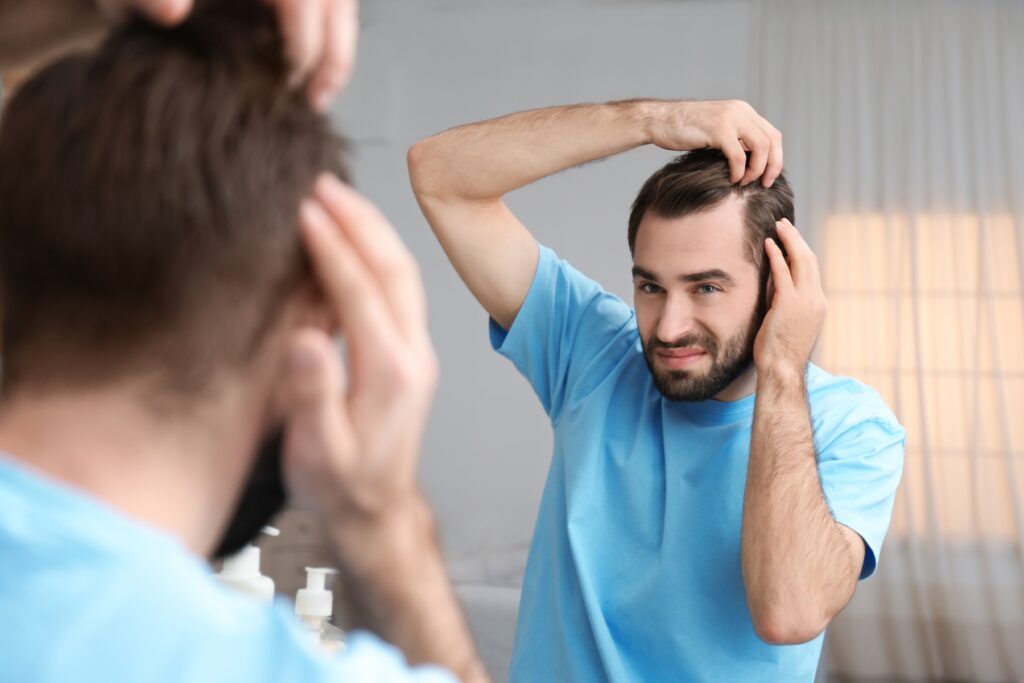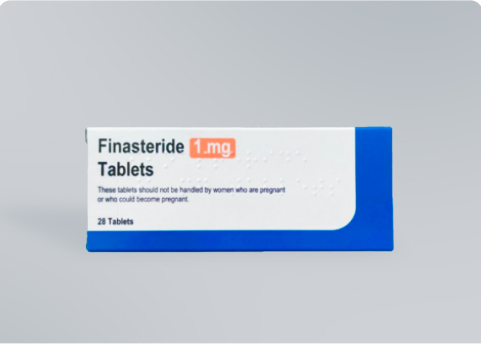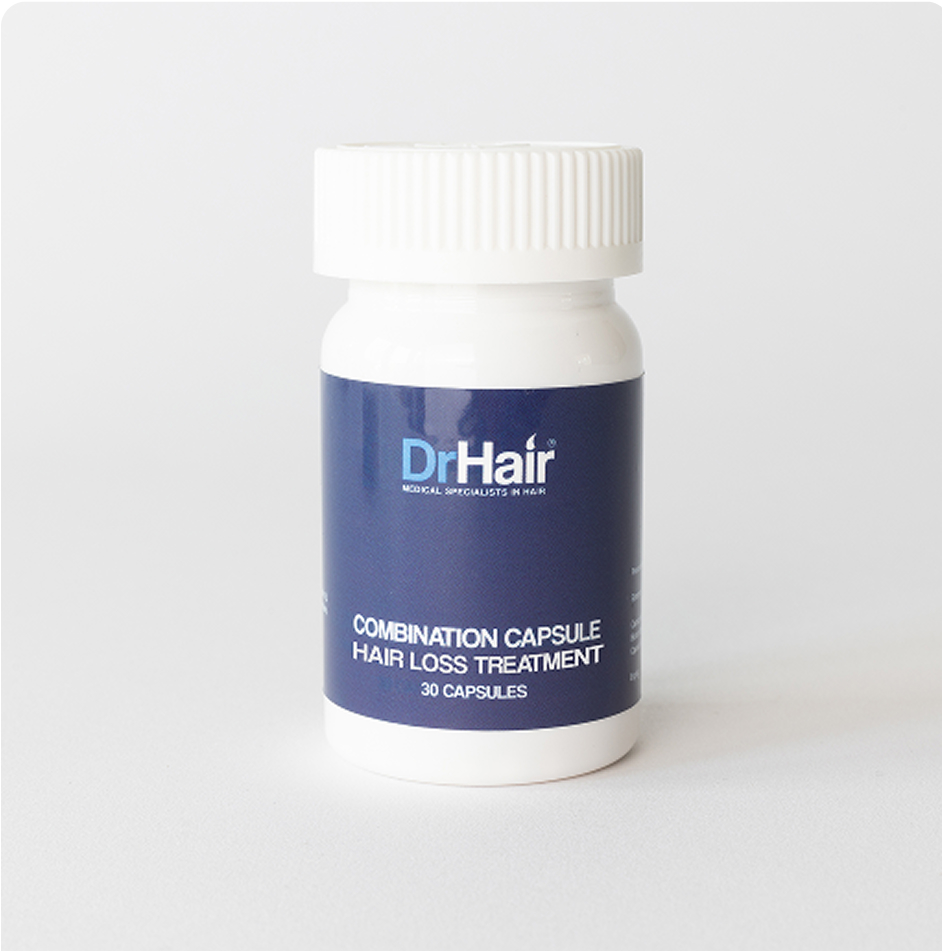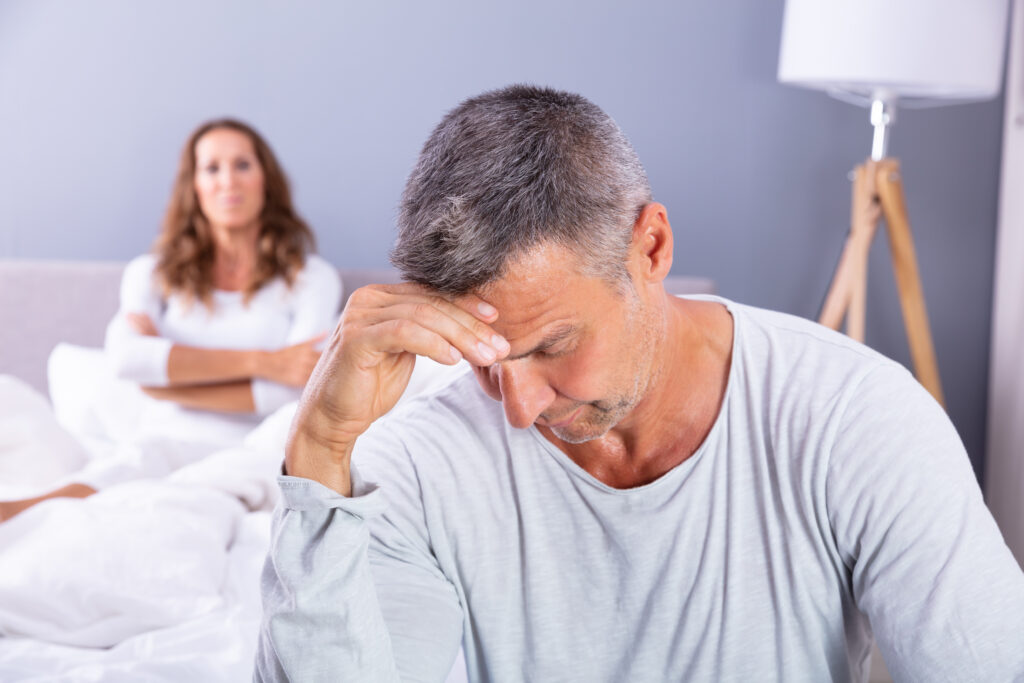Male pattern baldness is the most widespread type of hair loss, affecting a whopping 80% of men over the course of their lifetime [1]. So chances are, if you’re a man, you’re likely to start losing your hair at some point.
Hair thinning is a part of life, but some men lose hair much earlier than others. Fortunately, there are now ways you can treat and even prevent male pattern baldness from getting worse.
Here, you’ll learn how to spot the signs of early hair loss, what you can do to stop it progressing, and how and when to treat your symptoms.
What is male pattern baldness?
Male pattern baldness is a genetic condition that manifests as hair loss in specific areas on the scalp. The most commonly affected areas are:
- Temples — The two peaks either side of your forehead
- Hairline — The hair along your frontal hairline
- Crown — The domed area at the top of your head
The back and sides of the hair are usually unaffected. So even in the latter stages of male pattern baldness, you’ll be left with a ring of hair from ear to ear around the back of the head.
Male pattern baldness is progressive, which means it will get worse over time. The progressive nature of this condition is shown on the Norwood Scale.
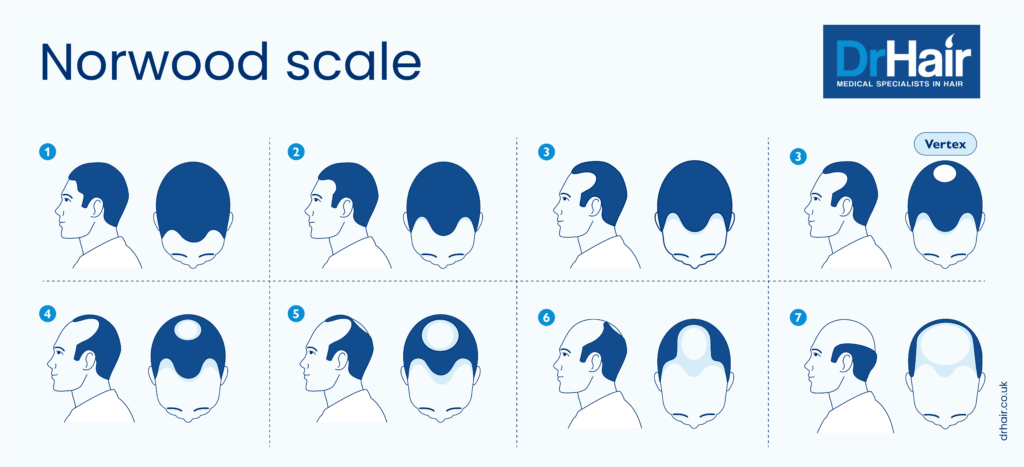
What causes male pattern baldness?
Male pattern baldness is caused by a combination of three important factors:
- Genetics
- Hormones
- Age
When you hit puberty, your hormone levels start to change. Research suggests testosterone production increases by around 30 times during puberty, which means more of this hormone is converted into dihydrotestosterone (DHT) [2].
DHT is responsible for the development of male pattern baldness, as it binds to receptors in the follicles and makes them shrink. As you get older, more follicles yield to this effect, leading to widespread balding across the scalp.
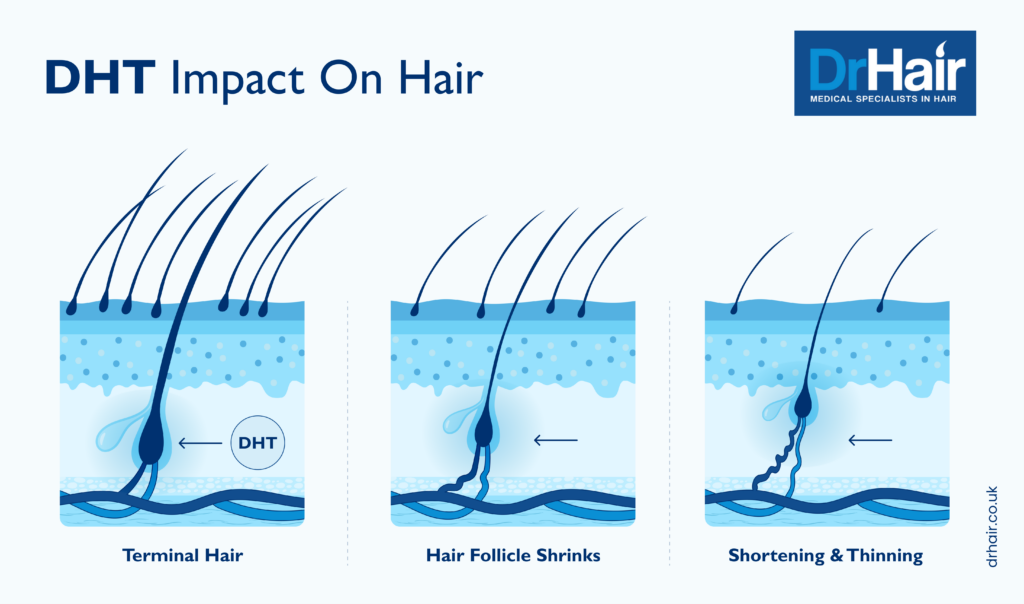
You’re more likely to go bald if male pattern baldness runs in your family. That’s because your genes determine your DHT levels and your sensitivity to DHT.
How to recognise male pattern baldness
Unsurprisingly, male pattern baldness develops in a very specific pattern that’s easy to recognise. And because it’s far more common than any other type of alopecia, it’s not usually mistaken for any other hair loss condition.
The signs of male pattern baldness are:
- A receding hairline characterised by deepening temples and a wider gap between your hairline and eyebrows.
- Thinning across the crown of your head (you can see your scalp through your hair).
- Eventually these areas meet, leaving you with very sparse hair through the mid-scalp.
These men show typical signs of male pattern baldness:
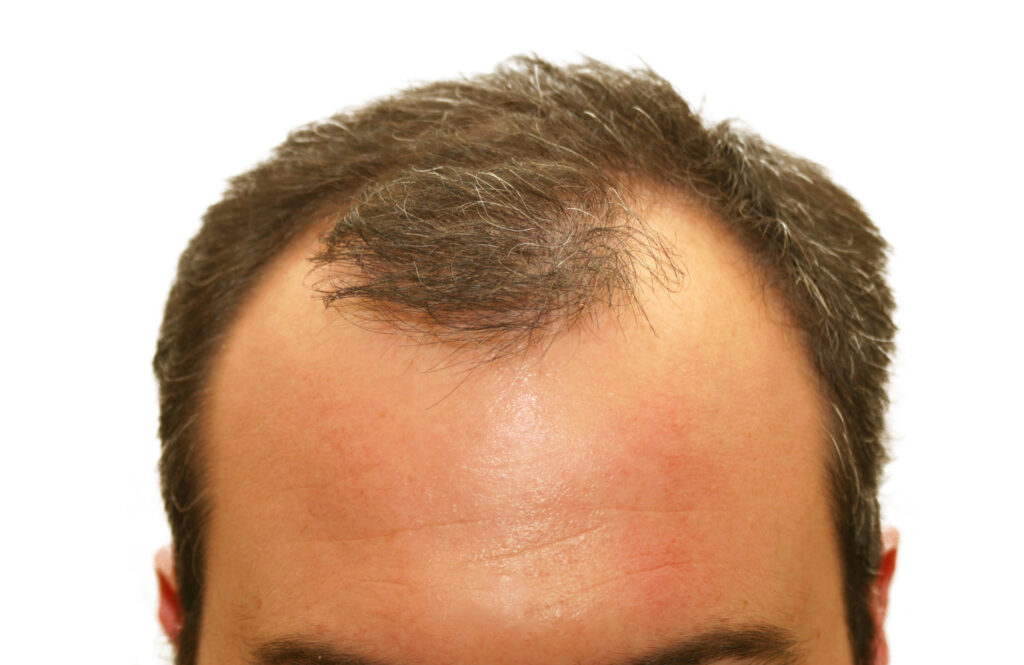
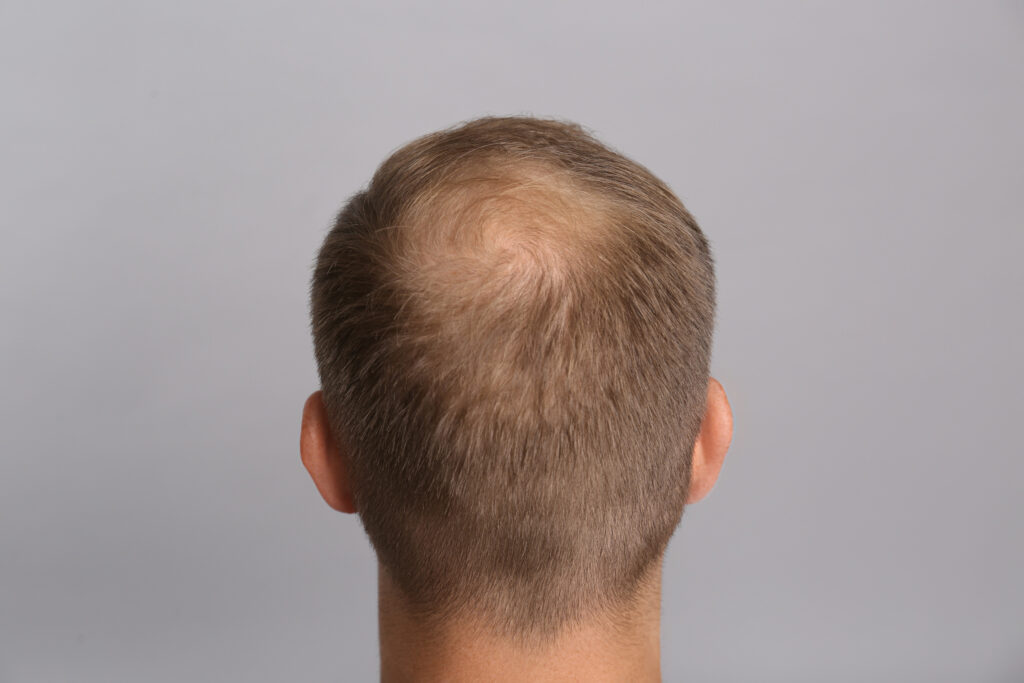
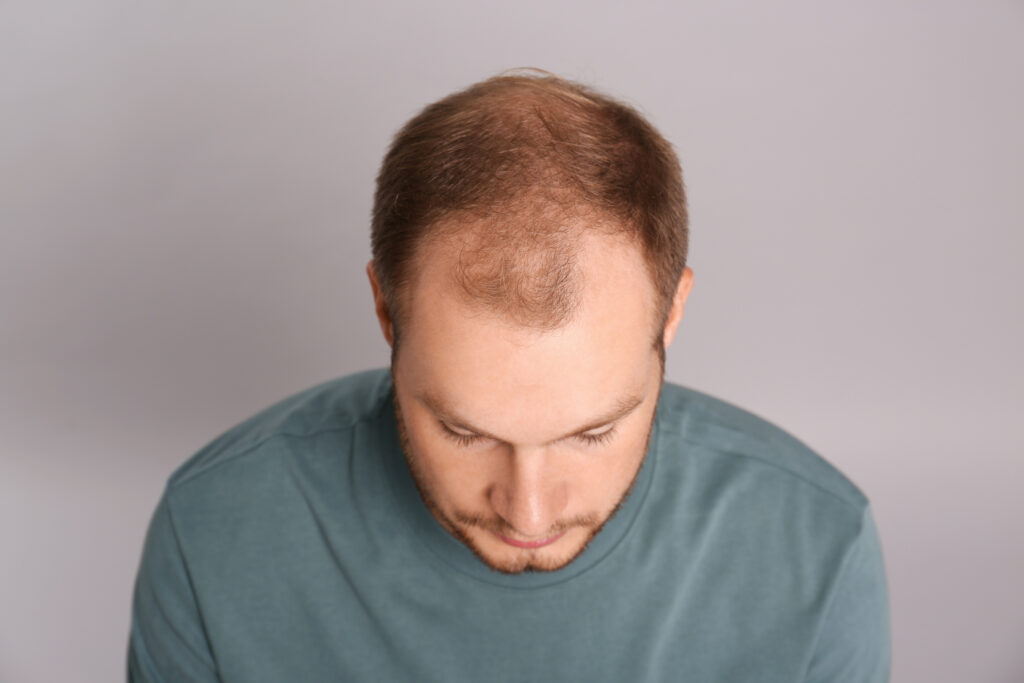
How is male pattern baldness diagnosed?
Male pattern baldness is normally easy for a trichologist or medical professional to diagnose visually. They’ll map your hair loss to the Norwood Scale to give you an indication of the extent of your balding. This can help you find the right treatment.
In rare cases, male pattern baldness symptoms may be confused with other conditions. For example, traction alopecia and frontal fibrosing alopecia can both cause receding hairlines in men. In these cases, you may need a more thorough examination to find the root cause of your hair loss.
Male pattern baldness risks and complications
While there’s no real health risk to going bald, some damaging conditions have been linked to genetic hair loss. Psychological problems like anxiety and depression can stem from losing your hair, as it can make you feel less confident when it comes to dating, work, and other social situations [3].
Additionally, men with male pattern baldness may be at greater risk of sunburn and related complications, such as skin cancer. This is rare, but may become more likely with repeated sun exposure. It’s important to cover your scalp with a hat or suncream when you’re out in the sun.
Preventing male pattern baldness

There’s no cure for male pattern baldness, and prevention often minimises the need for more significant treatments later on. So knowing how to prevent male pattern baldness is essential if you’re worried about going bald.
There’s no certain method for preventing male pattern baldness, but some medications give you a good chance. Let’s take a look at the preventative options available.
Finasteride
Finasteride is a drug designed to limit activity of the 5-alpha-reductase enzyme, which converts testosterone to DHT. Lower levels of DHT translate to slowed hair loss and can even allow some of your hair to grow back. Finasteride 1 mg tablets have been shown to stop crown hair loss in 83% of men, and the frontal hairline in 70% of men after a year of use [4].
Finasteride has been linked with sexual and psychological side effects, including erectile dysfunction and depression. Major side effects are rare, but it’s important to understand the risks before you start taking this medication, so find out how to reduce the side effects of finasteride.
After around 3 to 4 months of taking a daily 1 mg finasteride dose, you should start to see visible improvements in your hair. You’ll need to continue taking finasteride indefinitely to retain your results.
Dutasteride
Dutatseride is another 5-alpha-reductase inhibitor. It blocks all 3 types of the 5-alpha-reductase enzyme, whereas finasteride blocks just 2. As a result, dutasteride is very effective at preventing male pattern hair loss [5].
That said, it isn’t yet licensed for treating pattern baldness, so it’s not always prescribed as a first line treatment. Learn more about dutasteride vs finasteride for hair loss.
Treating male pattern baldness
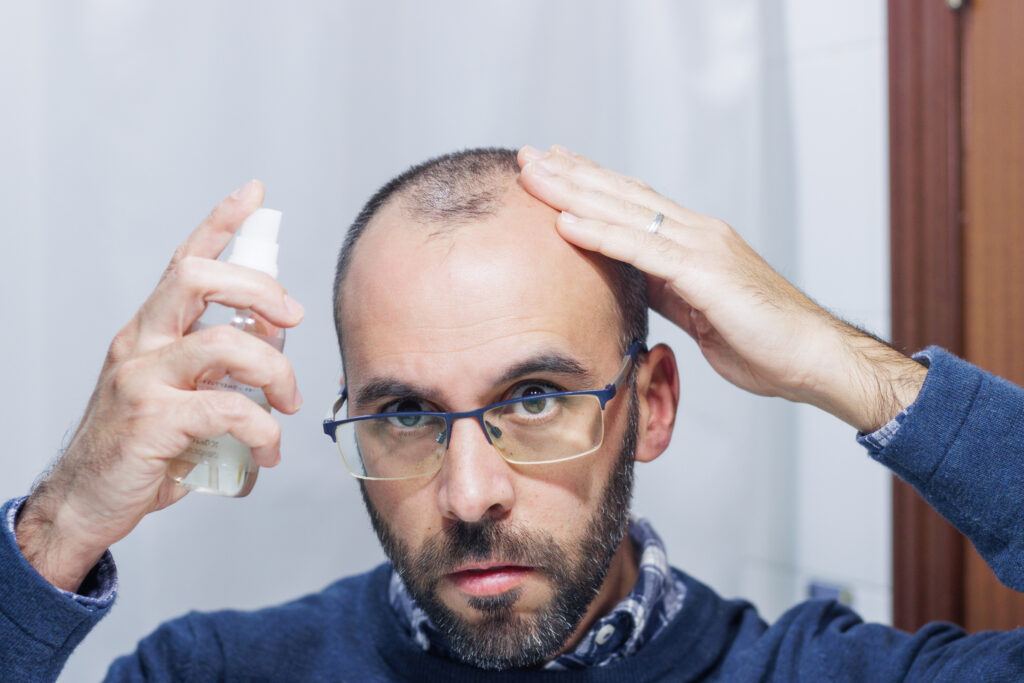
Even if you don’t start taking prevention medication at the first signs of thinning, it may not be too late to treat your hair loss. Finasteride and dutasteride can both be taken to stop and reverse thinning at later stages (although they are more effective the earlier they’re used).
There are several other treatments available for male pattern baldness.
Topical minoxidil
Like finasteride, minoxidil is licensed for treating male pattern baldness. Applying 5% minoxidil twice a day can help stimulate hair growth.
Topical minoxidil may cause itchiness and irritation on the scalp, but this is usually very mild. Learn more about minoxidil side effects.
Topical finasteride
Topical finasteride can give you the benefits of this active ingredient without the systemic side effects of oral finasteride. You can also safely combine topical finasteride + minoxidil to boost results. Learn more about the side effects of topical finasteride.
Oral minoxidil
Low-dose oral minoxidil can help regrow hair when taken regularly. Unlike topical minoxidil, it’s not licensed for treating hair loss, but studies have shown it to be highly effective for regrowing hair in men with male pattern baldness [6].
Oral minoxidil may have more systemic side effects than topical treatments. These include excessive body hair growth, dizziness, fluid retention, and headaches.
Platelet-rich plasma therapy
In PRP therapy, platelet-rich plasma from your own blood is injected into balding areas of your scalp to stimulate hair growth. This works due to the growth factors within the PRP.
You’ll need a course of injections over several months to see best results. You may also need to repeat the therapy to sustain any new growth.
Non-medical therapies
There is evidence that some noninvasive or natural remedies can help treat male pattern baldness. Scalp massage, rosemary oil, and microneedling have all been shown to help curb genetic hair loss when used consistently [7-9].
Tackle male pattern baldness with DrHair
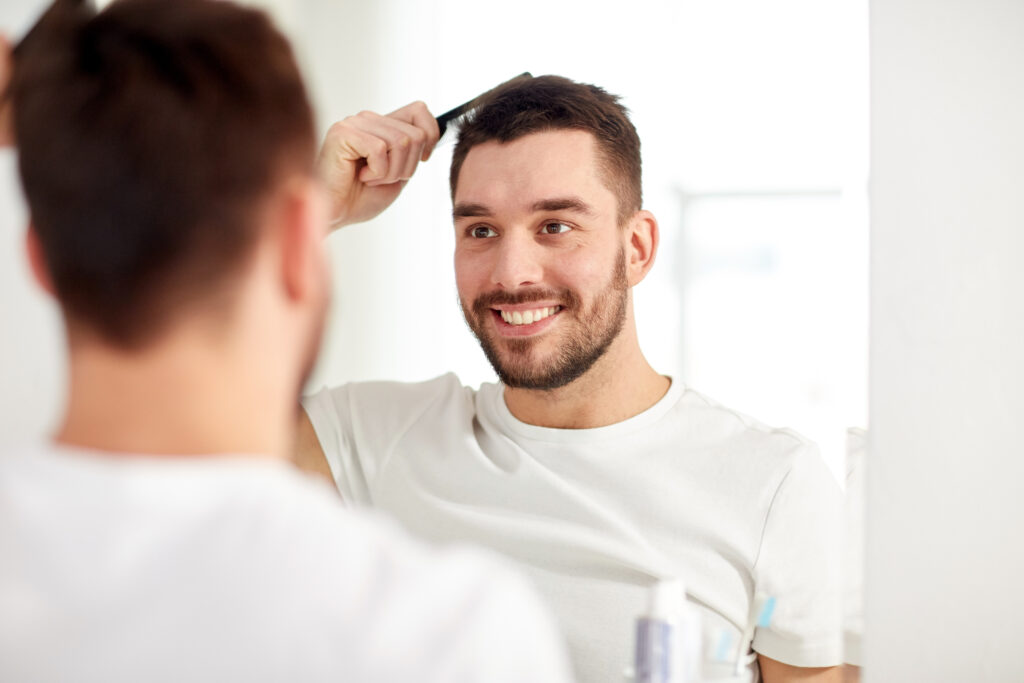
At DrHair, we specialise in supplying hair loss treatments to men affected by male pattern baldness, including minoxidil, finasteride, and combination treatments. Many men can safely combine oral finasteride + topical minoxidil to get the best possible results.
In addition, you’ll get:
- Assessment that takes less than a minute.
- Treatment either as a one-off purchase or on subscription.
- The best prices for your hair loss treatments.
- Quick, discreet delivery of your prescribed products.
Find the right hair loss products in our range and start tackling male pattern baldness today.
FAQs
Learn more about male pattern baldness in these frequently asked questions.
There’s no specific timeframe for male pattern baldness; it varies from person to person. Some men lose their hair quickly, while for others it can take several years or even decades.
Look to other men in your family (including those on your mother’s side) for an idea of how and when your hair loss might develop.
5-alpha-reductase inhibitors like finasteride are the most effective medical therapies for male pattern baldness. Minoxidil is also an excellent remedy, especially when used alongside finasteride.
If your hair still appears thin after a few months of using these treatments, a hair transplant may be your best option for restoring hair density.


